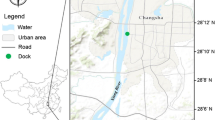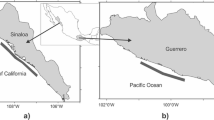Abstract
Zinc (Zn) and copper (Cu) concentrations were determined in the tissues (muscle, stomach, liver, gills, skin, and gonads) of five commercial fish species (mullet Liza haematocheilus, flathead Platycephalus indicus, mackerel Scomberomorus niphonius, silver pomfret Pampus argenteus, and sea bass Lateolabrax japonicus) from Laizhou Bay in the Bohai Sea. Metal bioaccumulation was highest in the metabolically active tissues of the gonads and liver. Bioconcentration factors for Zn were higher in all tissues (gonads 44.35, stomach 7.73, gills 7.72, liver 5.61, skin 4.88, and muscle 1.63) than the corresponding values for Cu (gonads 3.50, stomach 3.00, gills 1.60, liver 5.43, skin 1.50, and muscle 0.93). Mackerel tissues accumulated metal to higher concentrations than did other fish species, but bioaccumulation levels were not significantly correlated with the trophic levels of the fish. Zn and Cu concentrations in the tissues were generally negatively correlated with fish length, except for a few tissues of sea bass. Risk assessment based on national and international permissible limits and provisional tolerances for weekly intake of Zn and Cu revealed that the concentrations of these two metals in muscle were relatively low and would not pose hazards to human health.
Similar content being viewed by others
References
Administrative Department for Standardization of China. 2005. Maximum Levels of Contaminants in Foods, China’s National Standard GB 2762-2005. Standards Press of China, Beijing.
Al-Yousuf M H, El-Shahawi M S, Al-Ghais S M. 2000. Trace metals in liver, skin and muscle of Lethrinus lentjan fish species in relation to body length and sex. Sci. Total Environ., 256(2–3): 87–94.
Anan Y, Kunito T, Tanabe S, Mitrofanov I, Aubrey D G. 2005. Trace element accumulation in fishes collected from coastal waters of the Caspian Sea. Mar. Pollut. Bull., 51(8–12): 882–888.
Andres S, Ribeyre F, Tourencq J N, Boudou A. 2000. Interspecific comparison of cadmium and zinc contamination in the tissues of four fish species along a polymetallic pollution gradient (Lot River, France). Sci. Total Environ., 248(1): 11–25.
Bagenal T B, Tesch F W. 1978. Age and growth. In: Bagenal T B ed. Methods for Assessment of Fish Production in Fresh Waters, IBP Handbook, No. 3. Blackwell Scientific Publications, London. p.102–136.
Barron M G. 1995. Bioaccumulation and bioconcentration in aquatic organisms. In: Hoffman D J, Rattner B A, Burton Jr G A, Cairns Jr J eds. Handbook of Ecotoxicology, Lewis Publishers, Boca Raton, Florida. p.652–666.
Beyers D W, Farmer M S. 2001. Effects of copper on olfaction of Colorado pikeminnow. Environ. Toxicol. Chem., 20(4): 907–912.
Burger J, Gaines K F, Boring C S, Stephens W L Jr, Snodgrass J, Gochfeld M. 2001. Mercury and selenium in fish from the Savannah River: species, trophic level, and locational differences. Environ. Res., 87(2): 108–118.
Canli M, Atli G. 2003. The relationships between heavy metal (Cd, Cr, Cu, Fe, Pb, Zn) levels and the size of six Mediterranean fish species. Environ. Pollut., 121(1): 129–136.
Cui Y, Ma S S, Li Y P, Xing H Y, Wang M S, Xin F Y, Chen J F, Sun Y. 2003. Pollution situation in the Laizhou Bay and its effects on fishery resources. Mar. Fish. Res., 24(1): 35–41. (in Chinese with English abstract)
Fang X Y, Jiang T L. 1991. The characteristics of tidal current in Laizhou Bay. Coast. Eng., 10: 44–49. (in Chinese with English abstract)
Farkas A, Salánki J, Specziár A. 2002. Relation between growth and the heavy metal concentration in tissues of bream Abramis brama L. populating Lake Balaton. Arc. Environ. Con. Tox., 43(2): 236–243.
Farkas A, Salánki J, Specziár A. 2003. Age- and size-specific patterns of heavy metals in the tissues of freshwater fish Abramis brama L. populating a low-contaminated site. Water Res., 37(5): 959–964.
Fernandes C, Fontaínhas-Fernandes A, Peixoto F, Salgado M A. 2007. Bioaccumulation of heavy metals in Liza saliens from the Esmoriz-Paramos coastal lagoon, Portugal. Ecotox. Environ. Safe., 66: 426–431.
Filipović Marijić V, Raspor B. 2007. Metal exposure assessment in native fish, Mullus barbatus L., from the Eastern Adriatic Sea. Toxicol. Lett., 168(3): 292–301.
Food and Agriculture Organization. 1983. Complication of legal limits for hazardous substances in fish and fishery products. FAO Fis h. Circ., 764.
Hu N J, Shi X F, Huang P, Liu J H. 2011. Polycyclic aromatic hydrocarbons in surface sediments of Laizhou Bay, Bohai Sea, China. Environ. Earth Sci., 63(1): 121–133. (in Chinese with English abstract)
Jin X S, Zhao X Y, Meng T X, Cui Y. 2005. Biotic Resources and Their Habitats in the Bohai Sea and the Yellow Sea. Science Press, Beijing. (in Chinese)
Kalay M, Canli M. 2000. Elimination of essential (Cu, Zn) and non-essential (Cd, Pb) metals from tissues of a freshwater fish Tilapia zilli. Turk. J. Zoo l., 24: 429–436.
Kendrick M H, Moy M T, Plishka M J, Robinson K D. 1992. Metals and Biological Systems. Ellis Horwood Ltd., Chichester, UK.
Liu F, Wang H T, Wang D L. 2004. Spatial distributions of heavy metals from the Laizhou Bay littoral wetland. Adv. Mar. Sci., 22: 486–492. (in Chinese with English abstract)
Liu J H, Cao L, Huang W, Dou S Z. 2013. Species- and tissuespecific mercury bioaccumulation in five fish species from Laizhou Bay in the Bohai Sea of China. Chin. J. Oceanol. Limnol., 31(3): 34–43.
Liu W X, Chen J L, Lin X M, Fan Y S, Tao S. 2007. Residual concentrations of micropollutants in benthic mussels in the coastal areas of Bohai Sea, North China. Environ. Pollut., 146(2): 470–477.
Luo X X, Zhang R, Yang J Q, Liu R H, Tang W, Yan Q. 2010. Distribution and pollution assessment of heavy metals in surface sediment in Laizhou Bay. Ecol. Environ. Sci., 19(2): 262–269. (in Chinese with English abstract)
Mansour S A, Sidky M M. 2002. Ecotoxicological studies. 3. Heavy metals contaminating water and fish from Fayoum Governorate, Egypt. Food Chem., 78(1): 15–22.
Marcovecchio T D, Moreno V J. 1993. Cadmium, zinc and total mercury levels in the tissues of several fish species from La Plata river estuary, Argentina. Environ. Monit. Assess., 25(2): 119–130.
Márquez M, Vodopivez C, Casaux R, Curtosi A. 1998. Metal (Fe, Zn, Mn and Cu) levels in the Antarctic fish Notothenia coriiceps. Polar Biol., 20(6): 404–408.
Mcgeer J C, Brix K V, Skeaff J M, DeForest D K, Brigham S I, Adams W J, Green A. 2003. Inverse relationship between bioconcentration factor and exposure concentration for metals: implications for hazard assessment of metals in the aquatic environment. Environ. Toxicol. Chem., 22(5): 1 017–1 037.
Olsson P E, Larsson A, Haux C. 1988. Metallothionein and heavy metal levels in rainbow trout (Salmo gairdneri) during exposure to cadmium in water. Mar. Environ. Res., 24(1–4): 151–153.
Papagiannis I, Kagalou I, Leonardos J, Petridis D, Kalfakakou V. 2004. Copper and zinc in four freshwater fish species from Lake Pamvotis (Greece). Environ. Int., 30(3): 357–362.
Philips D J H. 1995. The chemistries and environmental fates of trace metals and organochlorines in aquatic ecosystems. Mar. Pollut. Bull., 31(4): 193–200.
Rainbow P S. 1993. Biomonitoring of marine heavy metal pollution and its application in Hong Kong waters. In: Morton B ed. The Marine Biology of the South China Sea. Hong Kong University Press, Hong Kong. p.235–250
Reist J D. 1985. An empirical evaluation of several univariate methods that adjust for size variation in morphometric data. Can. J. Zool., 63(6): 1 429–1 439.
Rotchell J M, Clarke K R, Newton L C, Bird D J. 2001. Hepatic metallothionein as a biomarker for metal contamination: age effects and seasonal variation in European flounders (Pleuronectes flesus) from the Severn Estuary and Bristol Channel. Mar. Environ. Res., 52(2): 151–171.
Simkiss K, Mason A Z. 1983. Metal ions: metabolic and toxic effects. In: Hochachka P W ed. The Mollusca, Vol.2, Environmental Biochemistry and Physiology. Academic Press, New York. p.101–164.
State Oceanic Administration of China. 1997. Sea Water Quality Standard, China’s National Standard GB 3097-1997. China Environmental Science Press, Beijing.
Svobodová Z, Dušek L, Hejtmánek M, Vykusová B, Šmid R. 1999. Bioaccumulation of mercury in various fish species from Orlík and Kamýk water reservoirs in the Czech Republic. Ecotox. Environ. Safe., 43(3): 231–240.
U.S. Environmental Protection Agency. 2000. Risk-based Concentration Table. Philadelphia, PA; Washington DC.
Vinikour W S, Goldstein R M, Anderson R V. 1980. Bioconcentration patterns of zinc, copper, cadmium and lead in selected fish species from the Fox River, Illinois. B. Environ. Contam. Tox., 24(5): 727–734.
Visnjic-Jeftic Z, Jaric I, Jovanovic L, Skoric S, Smederevac-Lalic M, Nikcevic M, Lenhardt M. 2010. Heavy metal and trace element accumulation in muscle, liver and gills of the Pontic shad (Alosa immaculat a Bennet 1835) from the Danube River (Serbia). Microchem. J., 95(2): 341–344.
Weatherly A H, Gill H S. 1987. The Biology of Fish Growth. Academic Press, Orlando.
World Health Organization. 2004. Summary of Evaluations Performed by the Joint FAO/WHO Expert Committee on Food Additives. International Life Sciences Institute (ILSI) Press, Washington DC.
Yang J, Xu X, Liu H B. 2009. Bioaccumulation of elements in icefish Protosalanx hyalocranius from the Taihu Lake and Hongze Lake. Oceanol. Limnol. Sin., 40(2): 201–207. (in Chinese with English abstract)
Author information
Authors and Affiliations
Corresponding author
Additional information
Supported by the National Natural Science Foundation of China for Creative Research Group (No. 41121064) and the International or Regional Research Cooperation and Exchange Project (No. 31061160187)
Rights and permissions
About this article
Cite this article
Liu, J., Cao, L., Huang, W. et al. Zinc and copper bioaccumulation in fish from Laizhou Bay, the Bohai Sea. Chin. J. Ocean. Limnol. 32, 491–502 (2014). https://doi.org/10.1007/s00343-014-3032-7
Received:
Accepted:
Published:
Issue Date:
DOI: https://doi.org/10.1007/s00343-014-3032-7




